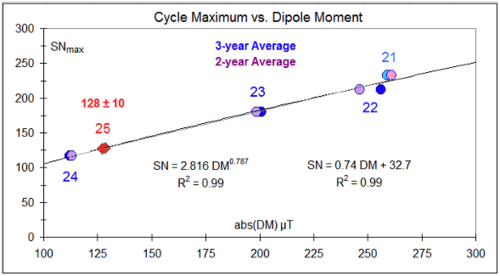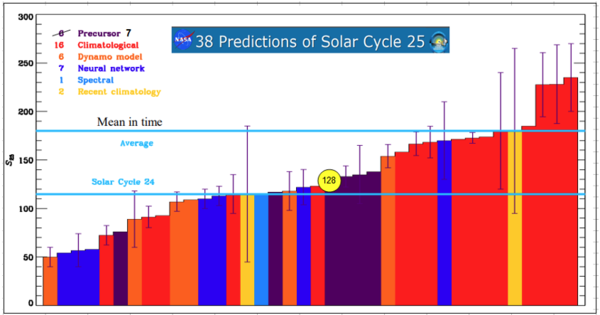Prediction of Solar Cycle 25
From RHESSI Wiki
(Created page with "{{Infobox Nugget |name = Nugget |title = Prediction of Solar Cycle 25 |number = 390 |first_author = Leif Svalgaard |second_author = |publish_date = 5 October2020 |next_nugget ...") |
|||
| (6 intermediate revisions not shown) | |||
| Line 5: | Line 5: | ||
|first_author = Leif Svalgaard | |first_author = Leif Svalgaard | ||
|second_author = | |second_author = | ||
| - | |publish_date = 5 | + | |publish_date = 5 October 2020 |
| - | |next_nugget = | + | |next_nugget = Current neutralization and eruptivity |
|previous_nugget = {{#ask: [[Category:Nugget]] [[RHESSI Nugget Index::389]]}} | |previous_nugget = {{#ask: [[Category:Nugget]] [[RHESSI Nugget Index::389]]}} | ||
}} | }} | ||
| - | == Introduction = | + | == Introduction == |
| - | The [https://en.wikipedia.org/wiki/Solar_cycle solar | + | The [https://en.wikipedia.org/wiki/Solar_cycle solar cycle] is driven |
by a self-exciting dynamo in the solar interior. | by a self-exciting dynamo in the solar interior. | ||
This dynamo effectively converts | This dynamo effectively converts | ||
| Line 34: | Line 34: | ||
next. | next. | ||
| - | Ref. [1] had suggested (four cycles ago) | + | Ref. [1] had suggested (four cycles ago), on assumed |
physical grounds (the | physical grounds (the | ||
[https://en.wikipedia.org/wiki/Babcock_Model Babcock-Leighton] model of the | [https://en.wikipedia.org/wiki/Babcock_Model Babcock-Leighton] model of the | ||
| Line 42: | Line 42: | ||
following the observed cycle-dependent concentration of surface fields in | following the observed cycle-dependent concentration of surface fields in | ||
the polar regions. | the polar regions. | ||
| - | + | They suggested using the average polar fields during the three-year interval | |
preceding solar minimum as the precursor value to regress against the | preceding solar minimum as the precursor value to regress against the | ||
| - | amplitude of the following cycle (Ref. [2]), and we examine this idea here. | + | amplitude of the following cycle (Ref. [2]), and we examine this idea here. |
== Result == | == Result == | ||
| Line 50: | Line 50: | ||
Using the measurements of the | Using the measurements of the | ||
[http://wso.stanford.edu Wilcox Solar Observatory] of the | [http://wso.stanford.edu Wilcox Solar Observatory] of the | ||
| - | solar axial magnetic dipole moment (DM), we | + | solar axial magnetic dipole moment (DM, calculated as the difference between the north and south polar fields), we |
[https://en.wikipedia.org/wiki/Regression_analysis regress] | [https://en.wikipedia.org/wiki/Regression_analysis regress] | ||
SN<sub>Max</sub> against the DM for Cycles 21-24, using both 3-year | SN<sub>Max</sub> against the DM for Cycles 21-24, using both 3-year | ||
and 2-year averages of DM prior to the solar minma (Figure 1). | and 2-year averages of DM prior to the solar minma (Figure 1). | ||
| - | + | Two separate regression fits have (likely fortuitously) very high | |
| - | coefficients of determination, R<sup>2</sup> | + | coefficients of determination, R<sup>2</sup> of 0.99. |
The resulting predicted SN maximum then comes to 128. | The resulting predicted SN maximum then comes to 128. | ||
| Line 69: | Line 69: | ||
]] | ]] | ||
| - | The earlier predictions of Refs. [2] and [ | + | The earlier predictions of Refs. [2] and [3] had missed by about |
6% overall. | 6% overall. | ||
On top of that, there is uncertainty in how well the sunspot number | On top of that, there is uncertainty in how well the sunspot number | ||
| Line 116: | Line 116: | ||
[4] [https://lasp.colorado.edu/media/projects/SORCE/meetings/2020/final/S6_01_Pesnell_SunClimate.pdf "How Well Can We Predict Solar Cycle 35?"] | [4] [https://lasp.colorado.edu/media/projects/SORCE/meetings/2020/final/S6_01_Pesnell_SunClimate.pdf "How Well Can We Predict Solar Cycle 35?"] | ||
| + | |||
| + | [5] [https://ui.adsabs.harvard.edu/abs/1907Natur..75..450G "Vox Populi"] | ||
Latest revision as of 08:58, 19 October 2020
| Nugget | |
|---|---|
| Number: | 390 |
| 1st Author: | Leif Svalgaard |
| 2nd Author: | |
| Published: | 5 October 2020 |
| Next Nugget: | Current neutralization and eruptivity |
| Previous Nugget: | Flare/CME Cartoon Archive |
| List all | |
Contents |
Introduction
The solar cycle is driven by a self-exciting dynamo in the solar interior. This dynamo effectively converts poloidal magnetic fields (basically extending north and south) into azimuthal or toroidal fields that erupt as solar active regions and sunspots. Solar variations across a cycle seem to form a family of curves well-characterized by a single parameter: SNMax, the maximum smoothed monthly sunspot number. Predicting the amplitude, shape, and duration of the next cycle thus concentrates on predicting SNMax for the cycle. The many empirical prediction methods that have been tried fall in two broad categories: statistical methods and precursor methods. The former assume that the centuries-long time-series of sunspot numbers carries information about the underlying physics that can be exploited for forecasting. The precursor methods assume that some properties of the recent cycles, perhaps only a part of the most recent ones, have predictive power for the next.
Ref. [1] had suggested (four cycles ago), on assumed physical grounds (the Babcock-Leighton model of the solar dynamo) that the magnetic field in the polar regions near minimum would be a precursor proxy for the amount of sunspot activity in the following cycle. It would provide a 'seed' for the dynamo when advected into the solar interior following the observed cycle-dependent concentration of surface fields in the polar regions. They suggested using the average polar fields during the three-year interval preceding solar minimum as the precursor value to regress against the amplitude of the following cycle (Ref. [2]), and we examine this idea here.
Result
Using the measurements of the Wilcox Solar Observatory of the solar axial magnetic dipole moment (DM, calculated as the difference between the north and south polar fields), we regress SNMax against the DM for Cycles 21-24, using both 3-year and 2-year averages of DM prior to the solar minma (Figure 1). Two separate regression fits have (likely fortuitously) very high coefficients of determination, R2 of 0.99. The resulting predicted SN maximum then comes to 128.

The earlier predictions of Refs. [2] and [3] had missed by about 6% overall. On top of that, there is uncertainty in how well the sunspot number represents actual solar activity. The modern SILSO sunspot data product lists a typical standard deviation of cycle-maximum of the sunspot number of 6%, for a combined error of 8.5% or 11 sunspot units for a SN of 128. We shall round that to 10 SN-units as even the unit digit is uncertain.
Conclusions
That the art of solar cycle prediction is still in its infancy is well borne out by the extreme range of predictions of Cycle 25 (Ref. [4]). Figure 2 indicates that we have not made much progress since predictions were made of Cycle 24, which showed a similar spread (from half to double of actual value observed). With the wide range (from 50 to 233), some individual one, or even several predictions are bound to be right regardless of the possible correctness of the method used. The many non-overlapping error bars illustrate the folly of even assigning error bars to the predictions or, at least, to believe in them. Our prediction is shown by the yellow circle in the middle of the plot, its diameter being its error bar, and we think that it is in a class by itself.

References
[1] "Using Dynamo Theory to predict the sunspot number during Solar Cycle 21"
[2] "Sunspot cycle 24: Smallest cycle in 100 years?"
[3] "Fair space weather for solar cycle 24"
[4] "How Well Can We Predict Solar Cycle 35?"
[5] "Vox Populi"
| RHESSI Nugget Date | 5 October 2020 + |
| RHESSI Nugget First Author | Leif Svalgaard + |
| RHESSI Nugget Index | 390 + |